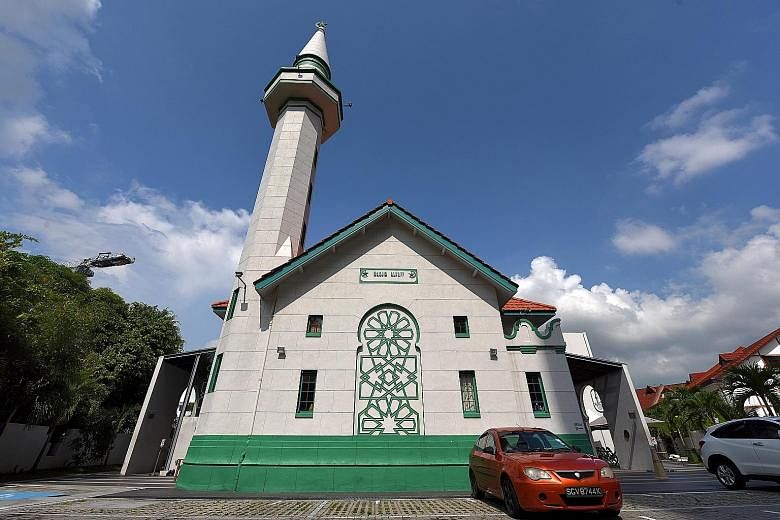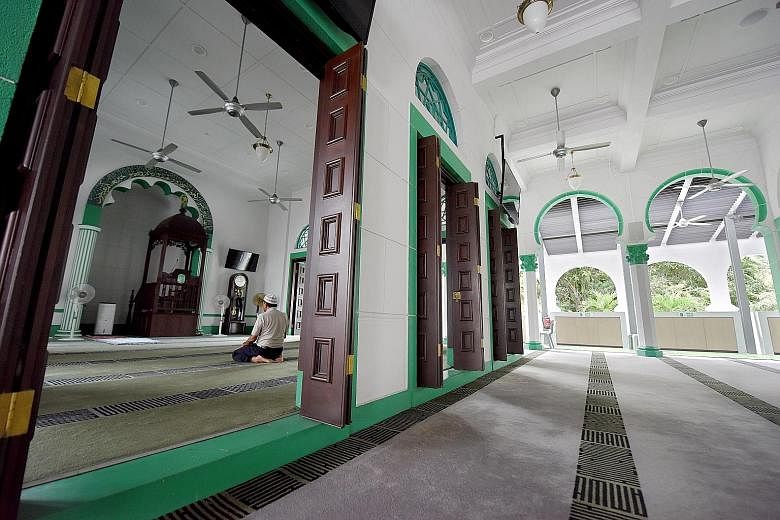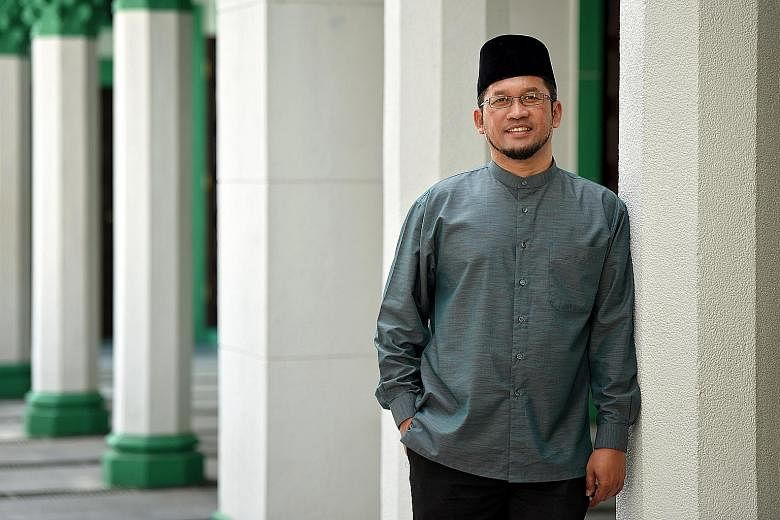From afar, Alkaff Upper Serangoon Mosque's minaret could easily be mistaken for a cathedral steeple.
Standing tall and proud, it was the only mosque to feature an Ottoman-style minaret back in the 1930s.
"I think that's the most distinctive part of the building," said mosque chairman Salehan Ahmad, 54. "It doesn't look like a mosque."
Alkaff Upper Serangoon Mosque's minaret is shaped like a pencil and was the tallest minaret islandwide when it was first erected.
Standing tall among the nearby rows of houses and shiny new condominium blocks, the minaret resembles a steeple at first glance. But Mr Salehan is not bothered by this clash of religious styles.
"It's the people that make a mosque," he explained. "If there is no one, the mosque will simply be a white elephant."
Built in 1930 by Syed Abdul Rahman Shaik Alkaff, the 68th national monument was an extension of the Alkaff family's tremendous wealth.
In the early 1800s, when Singapore was a newly established British port, the Arabs arrived as traders and merchants and became extremely successful in their businesses.
The Alkaff family, Arab traders from Yemen who dealt in spices, sugar and coffee between India and Indonesia, was one of such families, settling in Singapore in the 1850s to ply the spice trade.
Besides the Upper Serangoon mosque, they also once owned the Alkaff Kampung Melayu Mosque in Bedok, Alkaff Mansion in Telok Blangah, and the now defunct Alkaff Lake Gardens, which was situated off MacPherson Road .
In the 1920s, the Alkaffs engaged British architects to design and construct the mosque. "During the British colonial rule, British architects were more established," Mr Salehan said.
The minaret's design is influenced by the Classical Ottoman period, which, in turn, was heavily influenced by the Christian Byzantine tradition.
Initially, the Alkaffs hired Westerhout & Oman, a leading architectural firm, to design the mosque. Architectural plans were ready by 1927, but the sudden death of the firm's partner W. Campbell Oman stalled construction.
The Alkaffs then turned to British architectural firm Swan & Maclaren, another prominent firm that had built other national monuments such as the Sultan Mosque and Raffles Hotel.
With construction finally under way, the mosque was opened for public worship on June 24, 1932.
"A long-felt want has been met by the completion of the new mosque," said a Malaya Tribune newspaper article published on June 25, 1932. "The Muslims of the district feel deeply indebted (to the Alkaffs)."
For many, the mosque was also a place for socialising with members of the community.
"As a kid, I lived in this area when this was a very small mosque," recalled Mr Morsidi D. Abdullah, 68, who works at Hyflux Innovation Centre, near the mosque.
"I would meet my friends here, attend functions and, of course, come here for the food," he said, adding that the mosque's nasi briyani was his favourite.
Food would be served during functions such as Mawlid, Prophet Muhammad's birthday.
Mr Morsidi now goes to the mosque twice a day on weekdays to pray.
To accommodate the growing congregation, the mosque has gone through several rounds of renovation.
In 1998, it expanded to accommodate up to 800 worshippers from the Potong Pasir community. The growing congregation included Malays, Bangladeshi workers, Indian expatriates and Indonesian domestic helpers.
Fourteen years later, the mosque was closed to the public for almost two years for upgrading and restorative works under the Islamic Religious Council of Singapore's (Muis) Mosque Upgrading Programme.
"Now, the mosque is very spacious and we can see the original architecture," said Mr Salehan.
While the mosque has prayer space for 1,200 worshippers, it usually sees 70 to 80 people during Thursday and Friday night prayers, and 20 people at its other daily prayer sessions.
During occasions such as Nisfu Syaaban, a day of remembrance of the coming of Ramadan, the mosque sees up to 200 people in one night.
The mosque also offers a variety of religious classes for the Muslim community and skills-building classes for domestic workers.
"Every Sunday, we offer lessons in basic English competence, sewing and knitting for free," said Mr Salehan.
"We want to give maids a roof over their heads so that they can do their prayers here too."
The mosque has three caretakers who maintain the place daily.
One of them is Mr Samat Samjaka, 70, who has attended the mosque with his wife for more than 20 years.
"Now that I'm getting old, I'm considering retirement," said Mr Samat, who worked as a technician at the Maritime and Port Authority of Singapore for 30 years.
"It was difficult to pray at work sometimes," he said, adding that daily prayers are compulsory for Muslims.
"It's more convenient to pray while I work here, and it is nearer to my home in Toa Payoh."
The Singaporean, whose family is from Indonesia, also often catches up with old friends while he is at the mosque.
"The atmosphere is always very friendly, and I am happy here."



